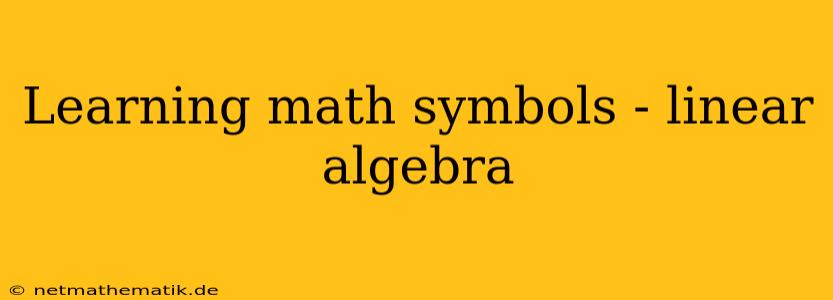Linear algebra is a branch of mathematics that deals with vectors, matrices, and systems of linear equations. It is a fundamental subject in mathematics, with applications in many different fields, including physics, engineering, computer science, and economics. One of the key aspects of understanding linear algebra is mastering the various mathematical symbols that are used to represent different concepts and operations. Learning these symbols is crucial for successfully navigating the world of linear algebra and effectively applying its principles. This article will delve into some of the essential mathematical symbols used in linear algebra, providing an overview of their meaning and purpose.
Vectors and Matrices
Vectors
Vectors are fundamental entities in linear algebra. They are essentially ordered lists of numbers, often representing quantities that have both magnitude and direction. In linear algebra, vectors are typically represented by boldface lowercase letters, such as v, u, w, etc.
Example: v = [1, 2, 3]
This represents a vector with three components: 1, 2, and 3.
Matrices
Matrices are rectangular arrays of numbers arranged in rows and columns. They play a critical role in linear algebra, providing a way to represent and manipulate systems of linear equations. Matrices are typically represented by uppercase letters, such as A, B, C, etc.
Example:
A =
[ 1 2 3 ]
[ 4 5 6 ]
[ 7 8 9 ]
This matrix A has three rows and three columns.
Operations on Vectors and Matrices
Vector Addition
To add two vectors of the same dimension, you simply add their corresponding components.
Example: u = [1, 2] v = [3, 4] u + v = [1 + 3, 2 + 4] = [4, 6]
Matrix Addition
Matrices can be added if they have the same dimensions. Addition is performed by adding corresponding elements.
Example:
A =
[ 1 2 ]
[ 3 4 ]
B =
[ 5 6 ]
[ 7 8 ]
A + B =
[ 1+5 2+6 ]
[ 3+7 4+8 ]
A + B =
[ 6 8 ]
[ 10 12 ]
Scalar Multiplication
Scalar multiplication involves multiplying a matrix or vector by a scalar (a single number). This is done by multiplying each element of the matrix or vector by the scalar.
Example: v = [1, 2, 3] 2v = 2[1, 2, 3] = [2, 4, 6]
Matrix Multiplication
Matrix multiplication is a more complex operation than scalar multiplication. The product of two matrices A and B is defined only if the number of columns in A equals the number of rows in B. The result is a matrix with the same number of rows as A and the same number of columns as B. The elements of the resulting matrix are calculated using the dot product of the corresponding row from A and the corresponding column from B.
Example:
A =
[ 1 2 ]
[ 3 4 ]
B =
[ 5 6 ]
[ 7 8 ]
A*B =
[ (1*5) + (2*7) (1*6) + (2*8) ]
[ (3*5) + (4*7) (3*6) + (4*8) ]
A*B =
[ 19 22 ]
[ 43 50 ]
Linear Transformations
Linear Transformations
A linear transformation is a function that maps vectors from one vector space to another vector space, preserving the operations of vector addition and scalar multiplication.
Example: Consider a linear transformation T from R² to R² defined by: T(x, y) = (x + y, 2x - y)
This transformation takes a vector (x, y) in R² and maps it to the vector (x + y, 2x - y) in R². This transformation preserves vector addition and scalar multiplication.
Matrix Representation of Linear Transformations
Linear transformations can be represented by matrices. The matrix representation of a linear transformation allows us to apply the transformation to vectors using matrix multiplication.
Example: The linear transformation T(x, y) = (x + y, 2x - y) can be represented by the matrix:
A =
[ 1 1 ]
[ 2 -1 ]
To apply this transformation to a vector v = (x, y), we can multiply v by the matrix A:
A*v =
[ 1 1 ] * [ x ] = [ x + y ]
[ 2 -1 ] [ y ] [ 2x - y ]
Other Important Symbols in Linear Algebra
Transpose of a Matrix (A<sup>T</sup>)
The transpose of a matrix is obtained by interchanging its rows and columns.
Example:
A =
[ 1 2 ]
[ 3 4 ]
AT =
[ 1 3 ]
[ 2 4 ]
Determinant of a Matrix (det(A))
The determinant of a square matrix is a scalar value that provides information about the matrix, including its invertibility.
Example:
A =
[ 2 1 ]
[ 4 3 ]
det(A) = (2 * 3) - (1 * 4) = 2
Inverse of a Matrix (A<sup>-1</sup>)
The inverse of a square matrix is another matrix that, when multiplied by the original matrix, results in the identity matrix.
Example:
A =
[ 2 1 ]
[ 4 3 ]
A-1 =
[ 3 -1 ]
[ -4 2 ]
A * A-1 =
[ 1 0 ]
[ 0 1 ]
Conclusion
Understanding the various mathematical symbols used in linear algebra is crucial for mastering this fundamental subject. From vectors and matrices to linear transformations and matrix operations, each symbol plays a significant role in representing concepts and expressing relationships within the realm of linear algebra. By familiarizing yourself with these symbols and their meanings, you can navigate this important field with greater confidence and clarity, paving the way for a deeper understanding and application of its principles.
